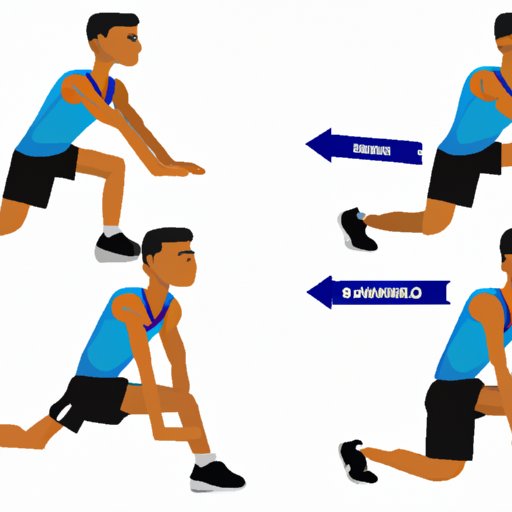
I. Introduction
Whenever you’re looking to sculpt your legs, strengthen your core, or even enhance your balance, the lunge should never be left out of your fitness routine. It is an incredibly versatile, compound, exercise that is perfect for full body workouts. This article will provide you with a beginner’s guide on how to perfect your lunge form, five variations to mix up your routine, and how to make it a safer, more effective exercise.
II. Mastering the Lunge: A Beginner’s Guide to Correct Form and Technique
The correct form and technique for lunges are incredibly crucial for efficiency and injury prevention. To make sure you are performing lunges correctly, stand upright with your feet hip-width apart, point your toes forward, and engage your core muscles.
Step forward with one leg and bend the knee, keeping your thigh parallel to the floor and your rear knee hovering just above the ground. Your front knee should be in line with your ankle, never allowing it to go beyond it. Straighten your front leg, and return to the starting position.
It may take some practice to perfect the lunge, but following some of these tips can make it easier:
- Keep your neck and shoulders relaxed, and your eyes forward.
- Take the lunge as far as your flexibility allows, do not over-exert.
- Ensure that your weight is evenly distributed on both legs, and your core is engaged.
Some common mistakes to avoid when doing lunges include having the knee tracks of your feet collapsing inward, rounding of shoulders or back arching, or performing the exercises regularly without sufficient break time to recover.
III. 5 Variations of the Lunge to Keep Your Workouts Interesting
If you find yourself bored with the basic lunge, there are a few variations that you can try:
- Reverse lunges: Instead of lunging forward, you step backward. This variation is suitable for those looking to target their glutes and hamstrings more effectively.
- Walking lunges: Move forward through a series of lunges with each step. This variation provides a full-body workout.
- Lateral lunges: This variation involves taking wide side-step lunges, focusing on the inner thighs.
- Curtsy lunges: Step back and behind on an angle with one leg, so your thighs are crossed as if you were making a curtsy. This variation targets the inner thighs effectively.
- Jumping lunges: Jump off the ground when alternating legs. This variation is perfect for increasing your heart rate and developing leg power.
It is essential to maintain proper form when performing these variations to maximize results and avoid injury.
IV. The Benefits of Adding Lunges to Your Exercise Routine
In addition to building lower body strength, lunges can also improve flexibility, balance, and posture. Practicing lunges can also help you achieve weight loss goals and overall fitness. This compound exercise engages multiple muscle groups, making it perfect for conditioning, and cardiovascular health. Researchers have found that doing lunges regularly helps to reduce oxidative stress and increase biochemical factors linked to muscle growth and repair.
V. How to Avoid Common Mistakes When Doing Lunges
Unfortunately, there are common mistakes that people make when doing lunges, but they can be prevented with some helpful tips. It would be best if you started with incorporating lunges into your routine gradually, so your body can adjust to the new exercise. Additionally, a stable base of support, maintaining good posture, and avoiding overuse of your knees can all contribute to better results.
It is essential to adjust and vary the intensity of your lunges as your strength and ability improve. Too much resistance or repetition without sufficient rest periods can lead to issues like muscle fatigue, overuse, or even injury.
VI. 10 Minute Lunges: A Quick and Effective Lower Body Workout
A quick lunge workout can be done anywhere and doesn’t require any special equipment. Try the following routine:
- 10 walking lunges per leg
- 20 reverse lunges
- 20 side lunges
- 10 curtsy lunges per leg
- 30 seconds of jumping lunges
Repeat this sequence twice for a quick and effective 10-minute workout.
VII. The Importance of Progression When Incorporating Lunges into Your Training
Incorporating progressive overload is key when looking to improve your lunges and overall fitness level. This could mean variations such as adding resistance or increasing the number of sets or reps performed. By doing this, you’ll keep your body challenged, prevent plateauing, and optimize results.
The key to progression is to take gradual steps, as overloading too much too soon can result in injury or muscle damage. Always ensure that you maintain proper form and focus on slowly building endurance.
VIII. Maximizing Your Results: Combining Lunges with Other Exercises for a Full-Body Workout
Maximizing the benefits of your lunge routine involves incorporating exercises that target other muscle groups. Squats, step-ups, hamstring curls, and other exercises can all be combined with lunges for a full-body workout. Combining exercises is a great way to target both the upper and lower body and facilitate strength and endurance improvements.
IX. Conclusion
In summary, lunges are a highly beneficial exercise that can improve overall fitness, strength, and posture. By finding the right variation for you and developing good technique and form, you can avoid common mistakes while maximizing results. Making gradual progressions and combining lunges with other exercises are also effective ways to achieve your goals and enhance your overall fitness routine.
So, whatever your motivation for adding lunges to your routine, get started today, and see the long-term benefits in your fitness and health.





